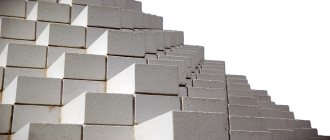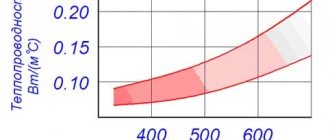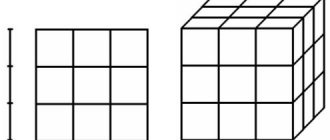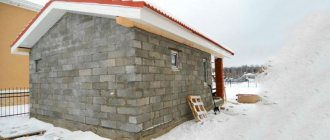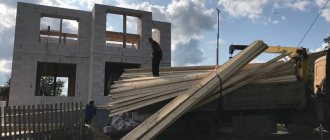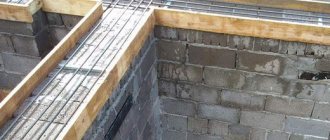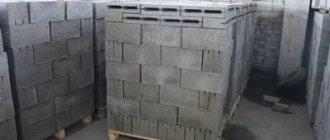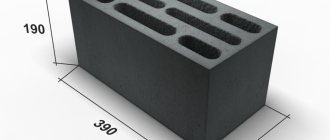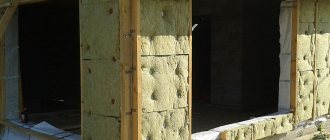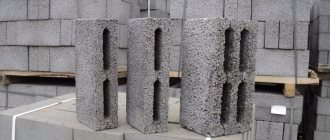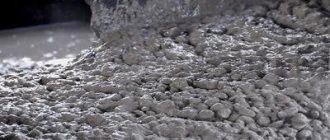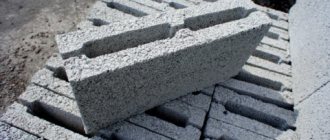When the time comes to choose a building material, it is necessary to study all its characteristics and properties in advance.
The thermal conductivity of expanded clay concrete blocks is important when building a house. This indicator depends on the density and porosity of the material, and since the blocks are not too dense, but rather have a porous structure, their indicator is low - therefore, they retain heat well in the house.
What does the concept mean?
This concept of expanded clay concrete stones means a value that characterizes the property of the material to conduct heat flow through the thickness of its composition from one surface to another. This ability is due to the presence of a transfer potential gradient in the material. Often this value is characterized using its inverse value - thermal resistance.
There are materials that transfer heat more slowly, and there are raw materials that transfer heat very quickly. For example, metal will transfer heat faster than thermal insulation materials, so they are often used additionally to retain heat in the house. Since expanded clay concrete stone does not contain a large amount of solid particles, with the exception of solid stones, its thermal conductivity is low.
What are expanded clay concrete blocks made of?
The production of expanded clay concrete involves adding expanded clay gravel, having fractions from 5 to 20 mm, and coarse expanded clay sand to the cement mortar. The size of the filler affects the strength and heat-saving characteristics of the block: the larger the gravel that is added to the molding mass, the less durable, but warmer the house turns out. To increase strength, frost resistance and fire safety, various chemical and mineral additives are also introduced into the mixture.
In order for products made of expanded clay concrete to meet technical specifications, the composition of the solution for preparing a specific brand is strictly regulated by GOST. Before purchasing blocks, you must make sure that the appropriate certificate and quality standard for this batch of goods is available. This will help you avoid purchasing low-quality goods from an unscrupulous manufacturer.
What does it depend on?
This parameter of stones depends on several factors:
- emptiness;
- dimensions;
- compound;
- porosity.
It is known that the more voids there are in a product, the better its thermal insulation properties. Solid products, in which there are no voids in the structure at all, that is, their voidness is 0%, have the highest thermal conductivity coefficient. However, such products are not able to retain heat inside the house, therefore, if you build walls from them, you will need additional thermal insulation with insulation.
The porosity of the material also affects this parameter . Expanded clay as part of the stone has a certain volume and is added to the product in a certain dispersion. The more pores in a material, the less its mass and density, therefore, these indicators also affect heat conductivity.
Important ! This indicator also depends on the composition of the block, or more precisely on the ratio of the brand and the starting materials in the structure.
Example of calculating wall thickness
The calculation must be made very accurately. It is necessary to take into account the best thickness of walls built from expanded clay concrete material. In order to make an accurate calculation, you need to use a special formula.
To do this, you need to know only two quantities: the coefficient of thermal conductivity and the coefficient of resistance to heat transfer. The first value is indicated by the symbol “λ”, and the second by “Rreg”. The value of the resistance coefficient is influenced by such factors as the weather conditions of the area where construction work will be carried out.
This coefficient can be determined according to building rules and regulations. The thickness of the future wall is indicated by the “δ” icon. And the formula for calculating it will look like this:
δ = Rreg x λ
For example, you can calculate the required wall thickness for building a building in Moscow or the Moscow region. The heat transfer resistance coefficient for this area has already been calculated and is approximately 3-3.1. The thickness of the block itself can be any, for example, let’s take 0.19 W. After making calculations using the above formula, we get the following:
δ = 3 x 0.19 = 0.57 m.
That is, the thickness of the walls should be 57 cm. Most experienced builders advise erecting walls with a thickness of 40 to 60 cm, provided that the building is located in the central regions of Russia.
Thus, by calculating a simple formula, you can build walls that will ensure not only the safety of the structure, but also its strength and durability. By completing this simple step, you can build a truly strong and reliable house.
The walls of private houses, cottages and other low-rise buildings are usually made of two or three layers with an insulating layer. The insulation layer is located on the load-bearing part of the wall made of bricks or small-format blocks. Developers often ask questions: “Is it possible to save on the thickness of the wall?” “Shouldn’t we make the load-bearing part of the wall of the house thinner than the neighbor’s or than provided for by the project?
On construction sites and in projects, you can see a load-bearing wall made of bricks with a thickness of 250 mm, and from blocks - even 200 mm. has become commonplace.
The wall turned out to be too thin for this house.
Odds table
To understand what the indicator is for expanded clay concrete stones, you can study the table below. It depends on the density of the product. Two columns show what thermal conductivity the stones have in a dry state and during operation.
| Product density | Dry value, W (m°C) | Value during operation, W (m°C) |
| 1800 | 0,7-0,8 | 0,8-0,9 |
| 1600 | 0,5-0,6 | 0,7-0,8 |
| 1400 | 0,4-0,5 | 0,6-0,7 |
| 1200 | 0,3-0,4 | 0,5-0,6 |
| 1000 | 0,2-0,3 | 0,4-0,5 |
| 800 | 0,1-0,2 | 0,4-0,3 |
| 600 | 0,1-0,15 | 0,25-0,3 |
| 500 | 0,1 | 0,15-0,25 |
How does wall thickness affect?
Once the heat conductivity has been determined, it is necessary to calculate the thickness of the structure.
For this purpose, the value of heat transfer resistance is also used, which depends on the type of building and the climatic conditions of the region in which the house is being built.
The parameter is also affected by the thickness of the wall. The thicker the wall, the higher its ability to conduct heat . And if the masonry is made of blocks that do not have voids, then it will have to be additionally insulated, since there is no air inside and the thermal insulation qualities of the walls are reduced.
Part 3. Minimum permissible value of wall resistance for various climatic zones.
The minimum permissible thermal resistance is calculated to analyze the thermal properties of the designed wall for various climatic zones. This is a standardized (basic) value that shows what the thermal resistance of the wall should be depending on the region. First, you select the material for the structure, calculate the thermal resistance of your wall (part 1), and then compare it with the tabular data contained in SNiP 02/23/2003. If the obtained value is less than that established by the rules, then it is necessary to either increase the wall thickness or insulate the wall with a heat-insulating layer (for example, mineral wool).
According to clause 9.1.2 of SP 23-101-2004, the minimum permissible heat transfer resistance Ro (m2 °C/W) of the building envelope is calculated as
Ro = R1+ R2+R3, where:
R1=1/αin, where αin is the heat transfer coefficient of the internal surface of enclosing structures, W/(m2 × °C), adopted according to Table 7 of SNiP 02/23/2003;
R2 = 1/αexternal, where αexternal is the heat transfer coefficient of the outer surface of the enclosing structure for cold period conditions, W/(m2 × °C), adopted according to Table 8 SP 23-101-2004;
R3 is the total thermal resistance, the calculation of which is described in Part 1 of this article.
If there is a layer in the enclosing structure that is ventilated by outside air, the layers of the structure located between the air layer and the outer surface are not taken into account in this calculation. And on the surface of the structure facing the layer ventilated by air from the outside, the heat transfer coefficient αext should be taken equal to 10.8 W/(m2 °C).
Table 2. Standardized values of thermal resistance for walls according to SNiP 02/23/2003.
| Residential buildings for various regions of the Russian Federation | Degree-days of the heating period, D, °С day | Standardized values of heat transfer resistance, R, m2 °C/W, of enclosing structures for walls |
| Astrakhan region, Stavropol region, Krasnodar region | 2000 | 2,1 |
| Belgorod region, Volgograd region. | 4000 | 2,8 |
| Altai, Krasnoyarsk region, Moscow, St. Petersburg, Vladimir region. | 6000 | 3,5 |
| Magadan region | 8000 | 4,2 |
| Chukotka, Kamchatka region, Vorkuta | 10000 | 4,9 |
| 12000 | 5,6 |
The updated values of degree-days of the heating period are indicated in Table 4.1 of the reference manual for SNiP 23-01-99* Moscow, 2006.
Requirements for expanded clay stones
Expanded clay and concrete blocks are subject to special requirements both in terms of thermal conductivity and other characteristics. This is regulated by the document GOST 33126-2014. There are separate requirements for load-bearing external and internal walls, as well as separately for non-load-bearing partitions.
For load-bearing external and internal walls
For the construction of load-bearing external and internal walls, it is recommended to use expanded clay concrete stones with medium density and thermal conductivity values of 0.1-0.2 W (m°C).
These are structural and thermal insulating blocks that are suitable for the construction of external walls, as they have a good ratio of solid particles to voids inside them. This material can also be used to insulate buildings from the outside.
Non-load bearing partitions
For non-load-bearing walls and partitions, a special partition stone of the heat-insulating type or structural-thermal insulation is suitable. This type of block is not designed for heavy loads, therefore it is used only indoors and does not act as a support for the floor slab.
Hollow blocks allow maximum heat retention due to the presence of a large number of holes or cracks. But such properties indicate that their thermal conductivity is low and equal to 0.1 W (m°C).
Main characteristics
Comparison table for the thermal conductivity of building materials.
The excellent heat and sound insulation properties of the material (shown in the table above) are due to its porous structure and density. This makes the blocks quite light. In the production of expanded clay concrete, a special annealing technology is used, similar to that used in the production of bricks.
The base of the blocks is a solution of cement, water, sand filler and expanded clay granules. In this case, the main role is played by the concentration and size of the latter in the composition.
As for the thermal conductivity itself, its coefficient is the amount of heat passing through a certain building element (body) per hour. In this case, the data is indicated for a body with a base area of 1 m2 and a thickness of 1 m.
Strength of materials
During the production of the blocks themselves, the number of granules in the composition can be varied, while creating elements with the desired characteristics. Taking them into account, expanded clay concrete blocks are divided into:
- Structural. Used to construct load-bearing elements of a building.
- Thermal insulating. They have low strength indicators, but provide high insulation.
- Structural and heat insulating. They have average strength and heat saving characteristics. Mainly used for the manufacture of prefabricated panels.
As the size of expanded clay granules in concrete increases, the ability of the material to transmit heat decreases, which makes it possible to construct structures with narrow walls in places where their level of strength will be sufficient to withstand the imposed loads.
Such material characteristics are a godsend for construction. With a small width of the walls and, accordingly, weight, there is no need to create a high-strength foundation, which reduces construction costs.
How to calculate?
For different climatic conditions, the thermal conductivity of the walls must be appropriate.
There are several tables on the Internet where you can find your region and understand what parameters should correspond to the weather conditions of the construction site. Then you can make your own calculations using the formula .
For example, before starting construction, when drawing up a project, it is necessary to calculate the thickness of the walls of the future house with comfortable temperature conditions for living in it. The formula always includes the thermal conductivity coefficient of the walls for the region; for this, the value of heat transfer resistance is also used.
The formula looks like this: δx Rreg=wall thickness for a specific region.
For example, the coefficient of resistance to heat transfer in Moscow is 3.28 sq.m x °C/W, and the thermal conductivity of an expanded clay concrete block with a density of 600 will be equal to 0.15 W (m°C). According to the formula 3.28 × 0.15 = 0.492 m. It follows that the average wall thickness for Moscow, subject to normal temperature inside the house, should be at least 49 cm if stones made of expanded clay and cement are used.
Advantages of expanded clay
Characteristics of expanded clay concrete in the table.
The material is also different:
- Completely safe for health. When living in structures built with expanded clay, there will be no deterioration in the condition of family members due to exposure to harmful substances on the body. It is environmentally friendly.
- Reduced labor costs for laying blocks due to the large size of the elements. At the same time, there is no need to hire special equipment or a team of workers to complete the work.
- Increased frost resistance (provided that high grades of cement are used) and high structure density. The level of temperature resistance depends on the structural purpose of the elements.
- Light weight - reduces the load on the base.
- The ability to maintain excellent performance for a long time.
- Vapor permeability. A house made of expanded clay will “breathe”.
By choosing expanded clay concrete blocks to build a house or other structure, you can get a strong and durable structure. The use of the material will allow, if the insulation, finishing and other components of the structure are selected correctly, to create an optimal environment for human habitation. Only at the design stage is it necessary to correctly calculate the width of the walls.
Consequences of choosing the wrong indicator
If you do not calculate the correct thermal conductivity of an expanded clay concrete block in a timely manner and use stone with inappropriate indicators, then the residents of the house may soon encounter problems. Firstly, the house will take a very long time to heat up , even when using heating appliances. If the stone is chosen correctly, then the house warms up completely within 2 hours, despite the fact that it had cooled down before.
Another problem is the need for additional insulation. This procedure will definitely entail spending money. It is necessary to approach the insulation process competently, so you need to involve specialists - this also leads to costs. Therefore, it is better to determine in advance the required thermal conductivity of expanded clay concrete block material and begin construction from it.
Opinion of building owners and builders
People who have used expanded clay concrete blocks for the construction of residential and non-residential buildings are satisfied with their choice.
- They note that living in such houses is comfortable.
- High-quality material is safe for health, as it is not filled with harmful impurities and gases.
- The elements are durable, this characteristic is not lost over the years.
- People are satisfied with the versatility of the blocks, since they can be used to build not only partitions, but also load-bearing walls.
The disadvantages include:
Difficulty drilling holes
This must be done carefully so as not to reach voids. The disadvantage is the need to carry out exterior finishing in the near future after completion of construction. For people with a limited budget, this seems financially expensive.. You can read more reviews here and here
You can read more reviews here and here.
